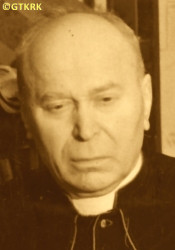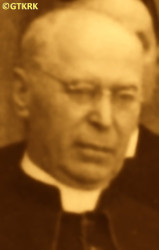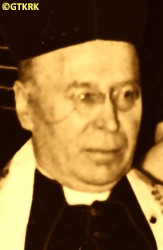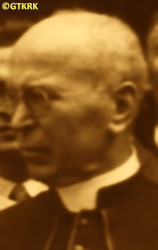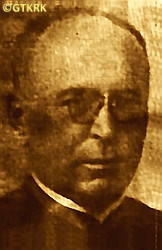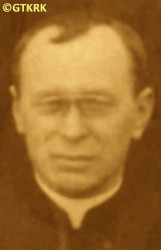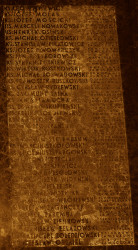Roman Catholic
St Sigismund parish
05-507 Słomczyn
85 Wiślana Str.
Konstancin deanery
Warsaw archdiocese, Poland
full list:
displayClick to display full list

searchClick to search full list by categories
wyświetlKliknij by wyświetlić pełną listę po polsku

szukajKliknij by przeszukać listę wg kategorii po polsku

Martyrology of the clergy — Poland
XX century (1914 – 1989)
personal data
surname
TRZECIAK
forename(s)
Stanislav Kostka (pl. Stanisław Kostka)
forename(s)
versions/aliases
Stanislav Kostka (pl. Stanisław Kostka)
function
diocesan priest
creed
Latin (Roman Catholic) Church RCmore on
en.wikipedia.org
[access: 2014.09.21]
diocese / province
Warsaw archdiocesemore on
en.wikipedia.org
[access: 2013.05.19]
Przemyśl diocesemore on
www.przemyska.pl
[access: 2013.02.15]
Mogilev archdiocesemore on
en.wikipedia.org
[access: 2013.06.23]
Cracow archdiocesemore on
en.wikipedia.org
[access: 2013.05.19]
academic distinctions
Doctor of Sacred Theology
honorary titles
Papal chamberlainmore on
en.wikipedia.org
[access: 2014.11.22]
(1923)
honorary canonmore on
en.wikipedia.org
[access: 2014.11.14]
(1923, Assumption of the Blessed Virgin Mary and St Stanislav the Bishop and Martyr RC archcathedral church, Mogilevtoday: Mogilev dist., Mogilev reg., Belarus
more on
en.wikipedia.org
[access: 2022.01.06])
„Polonia Restituta” Cross — 4th Class, Officer'smore on
en.wikipedia.org
[access: 2019.04.16]
(02.05.1923)
Order of the German Eaglemore on
en.wikipedia.org
[access: 2021.05.30]
(c. 1937)
Order of the Crown (Romania) — 3rd Class Commandermore on
en.wikipedia.org
[access: 2021.05.30]
Order of St. Sava (Yugoslavia) 4th Class — Officermore on
en.wikipedia.org
[access: 2021.05.30]
„Ideological Prisoner” — commemorative badge
„Cross of Valour”more on
en.wikipedia.org
[access: 2019.04.16]
Order of Saint Stanislav (Russian Empire) 3rd classmore on
en.wikipedia.org
[access: 2019.10.13]
(c. 1916)
date and place
of death
08.08.1944

Warsawtoday: Warsaw city pov., Masovia voiv., Poland
more on
en.wikipedia.org
[access: 2021.10.09]
alt. dates and places
of death
09.08.1944
details of death
During World War I 1914‐1918, co‐founder of the Polish Society for Aid to War Victims in Sankt Petersburg, taking care of Polish refugees affected by the war (originating from the lands of the Russian part of partitioned Poland, occupied by the Germans as a result of the Russian defeat in the Battle of Gorlice in 05.1915, which led to the panicky escape of c. 3 million Russian officials, administrative apparatus, army, teachers, and their families, etc. — the so‐called bezhenstvo — among whom were many Poles, treated by the Russians as officials of the Russian state) into the territory of Russia.
In 06.1918, after the fall of tsarism in Russia in 02.1917, the Bolshevik putsch in 10.1917, and the separatist peace treaty in Brest of 03.03.1918, signed by the Central Powers (i.e. the German Empire and the Austro–Hungarian Empire), returned to the territory of Poland, then still under German occupation.
Participant of the defence of Lviv, besieged by Ukrainians, during the Polish‐Ukrainian War of 1918‐1919.
In 1921, initiator of the campaign to help children returning from Russia.
In 1921 initiator of help to Polish children returning from Russia.
During the times of the Second Polish Republic, in his works was warning against the effects of communism. Believed that Bolshevism was a „great Jewish fraud” and that communism and Judaism were „equal concepts”.
Criticized also the National Socialist policy of Germany.
Was regarded as one of the best experts in the Jewish Talmud. Proclaimed that „national socialist ideology is permeated with the Jewish spirit, and racism is a concept taken directly from the spirit of the Talmud”. In the introduction to „The Talmud on Goyim and the Jewish Question in Poland” wrote however: „First of all, Poles need to learn from Jews national sense, solidarity, respect for national traditions, customs and traditions, to support each other morally and materially, just like Jews, and to expel from among themselves all elements that, although they admit to Polishness, are associated with the enemies of Poland and act to its detriment. It is also important that Poles learn from Jews frugality and foresight in practical life, and systematicity and planning in political and economic action”.
After German and Russian invasion of Poland in 09.1939 and start of the World War II, after start of German occupation founding member of pro‐German, anti‐Russian and anti‐Semitic National Radical Organisation NOR (dissolved in 01.1940).
Broke contacts with members of the organization in 03.1940 after attacks — possibly initiated by NOR, but controlled by Germans — of Jews in Warsaw and Kraków (Easter Pogrom).
Used contacts with Germans to help persecuted acquaintances — prob. helped the Jews as well.
There are however indications that in 1941 prob. denounced to the Germans a Polish Jewish priest, Fr Thaddeus Puder, hiding out of Warsaw (later saved by Polish nuns) — but according to some researchers, only confirmed widely known information without providing any new.
Published in German–controlled collaborationist „reptile press” —perhaps however these were just reprints of his pre‐war works, used by the Germans for propaganda purposes.
After outbreak on 01.08.1944 of Warsaw Uprising gave shelter in St Anthony's parish church to many people.
On 08/09.09.1944 Germans forced them, despite his protests, to remove a barricade build up by insurgents on Theatre Square.
After work Germans marched them off towards Albert King of Belgium Street, towards Wola district and Pruszków transit camp.
During march shot by a rank German soldier.
cause of death
mass murder
perpetrators
Germans
sites and events
Wola district massacresClick to display the description, DL 121 PruszkówClick to display the description, Warsaw UprisingClick to display the description, GeneralgouvernementClick to display the description, Ribbentrop‐MolotovClick to display the description, Pius XI's encyclicalsClick to display the description, Polish‐Ukrainian war of 1918‐1919Click to display the description
date and place
of birth
25.10.1873Birth certification on:
photos.szukajwarchiwach.gov.pl
[access: 2025.04.13]

Rudna Wielkatoday: Świlcza gm., Rzeszów pov., Subcarpathia voiv., Poland
more on
en.wikipedia.org
[access: 2021.10.09]
parents
TRZECIAK John
🞲 ?, ? — 🕆 ?, ?

MAJCHER Catherine
🞲 ?, ? — 🕆 ?, ?
baptism
26.10.1873Birth certification on:
photos.szukajwarchiwach.gov.pl
[access: 2025.04.13]

Świlczatoday: Świlcza gm., Rzeszów pov., Subcarpathia voiv., Poland
more on
en.wikipedia.org
[access: 2024.12.13]
St Simon and St Judas Thaddaeus the Apostles RC church
presbyter (holy orders)
ordination
1898

Przemyśltoday: Przemyśl city pov., Subcarpathia voiv., Poland
more on
en.wikipedia.org
[access: 2021.04.01]
positions held
1938 – 1944
parish priest — Warsawtoday: Warsaw city pov., Masovia voiv., Poland
more on
en.wikipedia.org
[access: 2021.10.09] ⋄ St Anthony of Padua RC parish ⋄ Warsaw‐in‐urbedeanery name
today: Warsaw city pov., Masovia voiv., Poland RC deanery
1928 – 1938
rector — Warsawtoday: Warsaw city pov., Masovia voiv., Poland
more on
en.wikipedia.org
[access: 2021.10.09] ⋄ St Jack the Confessor RC church ⋄ Warsaw‐in‐urbedeanery name
today: Warsaw city pov., Masovia voiv., Poland RC deanery — also: 03.1926‐09.1939 member of the Board of the Oriental Institute in Warsaw, one of the world's first Soviet research centers, and lecturer at the School of Oriental Studies operating at the Institute; collaborator of the „Monumenta Judaica” publication
1923 – 1928
parish priest — Dębowiectoday: Dębowiec gm., Jasło pov., Subcarpathia voiv., Poland
more on
en.wikipedia.org
[access: 2021.05.30] ⋄ St Bartholomew the Apostle RC parish ⋄ Żmigród Nowytoday: Nowy Żmigród, Nowy Żmigród gm., Jasło pov., Subcarpathia voiv., Poland
more on
en.wikipedia.org
[access: 2021.05.30] RC deanery
1907 – 1918
professor — Sankt Petersburgtoday: Saint Petersburg city, Russia
more on
en.wikipedia.org
[access: 2020.07.31] ⋄ Imperial Roman Catholic Spiritual Academy (1842‐1918) — lecturer in the Holy Scriptures of the New Testament; also: from 1912 member of the Imperial Russian Archaeological Society
1906 – 1907
secretary — Przemyśltoday: Przemyśl city pov., Subcarpathia voiv., Poland
more on
en.wikipedia.org
[access: 2021.04.01] ⋄ Consistory (i.e. Curia) ⋄ Przemyśl GK eparchy — also: 1906 co‐editor of the theological monthly „Przegląd Kościelny” (Eng. „Catholic Review”), Poznań
1903 – 1905
scientist — (Egypt and Palestine territory) — research on the local nature and diseases, especially leprosy
c. 1900 – c. 1901
vicar — Myślenicetoday: Myślenice gm., Myślenice pov., Lesser Poland voiv., Poland
more on
en.wikipedia.org
[access: 2021.06.07] ⋄ Nativity of the Blessed Virgin Mary RC parish ⋄ Myślenicetoday: Myślenice gm., Myślenice pov., Lesser Poland voiv., Poland
more on
en.wikipedia.org
[access: 2021.06.07] RC deanery
till 1900
PhD student — Krakówtoday: Kraków city pov., Lesser Poland voiv., Poland
more on
en.wikipedia.org
[access: 2021.06.07] ⋄ theology, Department of Theology, Jagiellonian University UJ — public defense PhD thesis on 13.07.1900
PhD student — Jerusalemtoday: Jerusalem dist., Israel
more on
en.wikipedia.org
[access: 2022.09.31] ⋄ theology
PhD student — Rometoday: Rome prov., Lazio reg., Italy
more on
en.wikipedia.org
[access: 2021.12.18] ⋄ theology
PhD student — Viennatoday: Vienna state, Austria
more on
en.wikipedia.org
[access: 2020.07.31] ⋄ theology
student — Freiburg im Breisgautoday: Freiburg im Breisgau urban dist., Freiburg reg., Baden‐Württemberg state, Germany
more on
en.wikipedia.org
[access: 2020.07.31] ⋄ theology, Albrecht and Louis University
till 1898
student — Przemyśltoday: Przemyśl city pov., Subcarpathia voiv., Poland
more on
en.wikipedia.org
[access: 2021.04.01] ⋄ philosophy and theology, Theological Seminary
writer and scientist — author of several dozen scientific works devoted to social issues (including „Education and prosperity. Economic and social study”, Poznań 1903, 1905; „Christ the Lord and the social question”, Poznań 1907), historical problems („The image of decay in Protestantism”, Warsaw 1903; „Political relations among Jews in the times of Christ the Lord”, Poznań 1905; „Literature and religion among the Jews in the times of Christ the Lord”, Warsaw 1911), to the Jewish question and Freemasonry („Talmud, Bolshevism and the project of marital law in Poland”, Warsaw 1932; „Messianism and the Jewish Question”, Warsaw 1934; „Talmud on the goyim – Gentiles and the Jewish Question in Poland”, Warsaw 1939); author of memoires „Impressions from a trip to Egypt”, Poznań 1904; publicist in the „Mały Dziennik” (Eng. „Little Daily”) of the Order of Friars Minor Conventual OFMConv, „Przegląd Katolicki” (Eng. „Catholic Review”), „Pro Christo”, „Prosto z Mostu” (Eng. „On the Level”), „Gazeta Warszawska” (Eng. „Warsaw Gazette”), „Myśl Narodowa” (Eng. „National Thought”)
comments
The case of the „denunciation” of Fr Thaddeus Puder by Fr Trzeciak cannot be taken out from the historical context:
21.11.1939 — Fr Puder begins his ministry as vicar in Białołęka Dworska (then outside Warsaw)
27.04.1940 — establishment of KL Auschwitz by the Germans (for Polish political prisoners)
16.11.1940 — establishment and isolation of the Warsaw ghetto, welcomed by some Jewish communities (establishment of the Judenrat — Jewish administrative council, establishment of the Jüdischer Ordnungsdienst police, i.e. the Jewish Police Service).
22.03.1941 — interrogation of Fr Trzeciak by the German political police Gestapo.
When asked by a German who interrogated him about Fr Puder volunteers known information about him.
It seems that this was commonly known knowledge.
Also the knowledge of the whereabouts of Fr Puder, as it seems, was not a secret at the time.
Fr Puder wasn't yet in hiding.
03.1941 — visit of the head of the SS, Heinrich Himmler, in KL Auschwitz.
Decision to expand the camp (from 10,000 to 30,000 prisoners) and the decision to establish KL Auschwitz II (Brzezina) — later the Birkenau extermination camp for Jews.
24.04.1941 — Fr Puder's arrest by the Germans in Białołęka Dworska — ostentatiously for refusing to wear a headband with a Jewish star.
22.06.1941 — German attack of the erstwhile ally, the Russians
22.01.1942 — conference in Wannsee — decision to commence Endlösung der Judenfrage
12.11.1942 — escape of Fr Puder from the hospital in Warsaw, with the help of Catholic nuns and the Polish resistance Home Army AK.
From then on, he hid in the same Białołęka Dworska, where he was a vicar and was previously arrested.
Whether it was a „denunciation” let historians judge.
Not propagandists.
others related
in death
PUDERClick to display biography Thaddeus Marian, BEDNARZClick to display biography Francis (Bro. Josaphat), BOGACZClick to display biography Steven (Bro. Steven), DOLEŻALClick to display biography Ferdinand, DOLIŃSKIClick to display biography Thaddeus, DUDAClick to display biography Felix (Bro. Aquinas), DZIERZGWAClick to display biography Marian, GÓRSKIClick to display biography Edmund Simon, JACHIMOWSKIClick to display biography Thaddeus Julian, KACZEWSKIClick to display biography Francis, KALISZEWICZClick to display biography Anthony, KANIAClick to display biography Joseph Ignatius, KAPUSTAClick to display biography Joseph, KOLAKClick to display biography Stanislav (Bro. Bogumil), KOTYŃSKIClick to display biography Henry, KRYGIERClick to display biography Mieczyslav, KRZYWIŃSKIClick to display biography Stanislav (Bro. Raphael), KULESZAClick to display biography Stanislav, MAJGIERClick to display biography Francis, MALISZClick to display biography Vladislav Lawrence, MĄCZKAClick to display biography Stanislav Andrew, MIKOŁAJSKIClick to display biography Leo (Bro. Ambrose), MOTYKAClick to display biography Boleslav, MÜLLERClick to display biography Thaddeus, NOWAKOWSKIClick to display biography John, PALEWSKIClick to display biography Joseph, PONIEWIERSKIClick to display biography Joseph (Bro. Philip), PROTASIEWICZClick to display biography Theodos (Fr Teophan), RACZKOClick to display biography Raphael Conrad John, ROMANClick to display biography Louis (Bro. Cornelius), RUCIŃSKIClick to display biography Anthony, SANIKOWSKI–DZIEGIEĆClick to display biography Leonard, SZYMLIKClick to display biography John, SZYMSKIClick to display biography Anthony, ŚWIERCZEKClick to display biography John Nepomucene, WERESZCZYŃSKIClick to display biography Bronislav, ZASADNIClick to display biography Francis
sites and events
descriptions
Wola district massacres: Mass extermination of the inhabitants of Warsaw Wola and Ochota districts, perpetrated by the Germans in the first days of Warsaw Uprising. Approx. 38,000‐65,000 Poles, men, women and children were massacred (the peak of the barbarian killings took place on 05‐07.08.1944). The massacre — genocide in fact — was in direct response to Adolf Hitler’s order to crash and destroy Warsaw and kill all of its citizens and was perpetrated by German SS units and Russian SS RONA units (with Belarusian contingent) collaborating with them. (more on: pl.wikipedia.orgClick to attempt to display webpage
[access: 2021.12.19])
DL 121 Pruszków: Germ. Durchgangslager 121 Pruszków (Eng. Transit Camp) — transit camp where Germans herded Warsaw (and its vicinity) civilian population captured during and after Warsaw Uprising. Set up on 06.01.1944 functioned till 12.1944. C. 390,000‐410,000 people were held captive. Most of them were sent subsequently to concentration camps and forced slave labour in Germany. Few hundred ‐ few thousands of them perished in the camp. (more on: pl.wikipedia.orgClick to attempt to display webpage
[access: 2015.03.01])
Warsaw Uprising: Lasted from 01.08.1944 till 03.10.1944. Was an attempt to liberate Polish capital from occupying Germans by the Polish Clandestine State — a unique in the history of the world political structure on the territories occupied by the Germans, effectively governing clandestinely in Poland — and by fighting on its behalf underground military units, mainly of Home Army (former Armed Struggle Association ZWZ) and National Armed Forced (NSZ). At the same time Russians stopped on purpose the offensive on all front, halted on the other bank of Vistula river and watched calmly the annihilation of the city, refusing even the mid‐landing rights to the Allied planes carrying weapons and supplies to the insurgents from Italy. During the Uprising Germans murdered approx. 200,000 Poles, mainly civilians. Approx. 200 priests and nuns died in fighting or were murdered by the Germans, many in mass executions. (more on: en.wikipedia.orgClick to attempt to display webpage
[access: 2013.08.17])
Generalgouvernement: After the Polish defeat in the 09.1939 campaign, which was the result of the Ribbentrop‐Molotov Pact and constituted the first stage of World War II, and the beginning of German occupation in part of Poland (in the other, eastern part of Poland, the Russian occupation began), the Germans divided the occupied Polish territory into five main regions. In two of them new German provinces were created, two other were incorporated into other provinces. However, the fifth part was treated separately, and in a political sense it was supposed to recreate the German idea from 1915 (during World War I, after the defeat of the Russians in the Battle of Gorlice in 05.1915) of creating a Polish enclave within Germany. Illegal in the sense of international law, i.e. Hague Convention, and public law, managed by the Germans according to separate laws — especially established for the Polish Germ. Untermenschen (Eng. subhumans) — till the Russian offensive in 1945 it constituted part of the Germ. Großdeutschland (Eng. Greater Germany). Till 31.07.1940 formally called Germ. Generalgouvernement für die besetzten polnischen Gebiete (Eng. General Government for the occupied Polish lands) — later simply Germ. Generalgouvernement (Eng. General Governorate), as in the years 1915‐1918. From 07.1941, i.e. after the German attack on 22.06.1941 against the erstwhile ally, the Russians, it also included the Galicia district, i.e. the Polish pre‐war south‐eastern voivodeships. A special criminal law was enacted and applied to Poles and Jews, allowing for the arbitrary administration of the death penalty regardless of the age of the „perpetrator”, and sanctioning the use of collective responsibility. After the end of the military conflict of the World War UU, the government of the Germ. Generalgouvernement was recognized as a criminal organization, and its leader, governor Hans Frank, guilty of war crimes and crimes against humanity and executed. (more on: en.wikipedia.orgClick to attempt to display webpage
[access: 2024.12.13])
Ribbentrop‐Molotov: Genocidal Russian‐German alliance pact between Russian leader Joseph Stalin and German leader Adolf Hitler signed on 23.08.1939 in Moscow by respective foreign ministers, Mr. Vyacheslav Molotov for Russia and Joachim von Ribbentrop for Germany. The pact sanctioned and was the direct cause of joint Russian and German invasion of Poland and the outbreak of the World War II in 09.1939. In a political sense, the pact was an attempt to restore the status quo ante before 1914, with one exception, namely the „commercial” exchange of the so‐called „Kingdom of Poland”, which in 1914 was part of the Russian Empire, fore Eastern Galicia (today's western Ukraine), in 1914 belonging to the Austro‐Hungarian Empire. Galicia, including Lviv, was to be taken over by the Russians, the „Kingdom of Poland” — under the name of the General Governorate — Germany. The resultant „war was one of the greatest calamities and dramas of humanity in history, for two atheistic and anti‐Christian ideologies — national and international socialism — rejected God and His fifth Decalogue commandment: Thou shall not kill!” (Abp Stanislav Gądecki, 01.09.2019). The decisions taken — backed up by the betrayal of the formal allies of Poland, France and Germany, which on 12.09.1939, at a joint conference in Abbeville, decided not to provide aid to attacked Poland and not to take military action against Germany (a clear breach of treaty obligations with Poland) — were on 28.09.1939 slightly altered and made more precise when a treaty on „German‐Russian boundaries and friendship” was agreed by the same murderous signatories. One of its findings was establishment of spheres of influence in Central and Eastern Europe and in consequence IV partition of Poland. In one of its secret annexes agreed, that: „the Signatories will not tolerate on its respective territories any Polish propaganda that affects the territory of the other Side. On their respective territories they will suppress all such propaganda and inform each other of the measures taken to accomplish it”. The agreements resulted in a series of meeting between two genocidal organization representing both sides — German Gestapo and Russian NKVD when coordination of efforts to exterminate Polish intelligentsia and Polish leading classes (in Germany called «Intelligenzaktion», in Russia took the form of Katyń massacres) where discussed. Resulted in deaths of hundreds of thousands of Polish intelligentsia, including thousands of priests presented here, and tens of millions of ordinary people,. The results of this Russian‐German pact lasted till 1989 and are still in evidence even today. (more on: en.wikipedia.orgClick to attempt to display webpage
[access: 2015.09.30])
Pius XI's encyclicals: Facing the creation of two totalitarian systems in Europe, which seemed to compete with each other, though there were more similarities than contradictions between them, Pope Pius XI issued in 03.1937 (within 5 days) two encyclicals. In the „Mit brennender Sorge” (Eng. „With Burning Concern”) published on 14.03.1938, condemned the national socialism prevailing in Germany. The Pope wrote: „Whoever, following the old Germanic‐pre‐Christian beliefs, puts various impersonal fate in the place of a personal God, denies the wisdom of God and Providence […], whoever exalts earthly values: race or nation, or state, or state system, representatives of state power or other fundamental values of human society, […] and makes them the highest standard of all values, including religious ones, and idolizes them, this one […] is far from true faith in God and from a worldview corresponding to such faith”. On 19.03.1937, published „Divini Redemptoris” (Eng. „Divine Redeemer”), in which criticized Russian communism, dialectical materialism and the class struggle theory. The Pope wrote: „Communism deprives man of freedom, and therefore the spiritual basis of all life norms. It deprives the human person of all his dignity and any moral support with which he could resist the onslaught of blind passions […] This is the new gospel that Bolshevik and godless communism preaches as a message of salvation and redemption of humanity”… Pius XI demanded that the established human law be subjected to the natural law of God , recommended the implementation of the ideal of a Christian state and society, and called on Catholics to resist. Two years later, National Socialist Germany and Communist Russia came together and started World War II. (more on: www.vatican.vaClick to attempt to display webpage
[access: 2023.05.28], www.vatican.vaClick to attempt to display webpage
[access: 2023.05.28])
Polish‐Ukrainian war of 1918‐1919: One of the wars for borders of the newly reborn Poland. At the end of 1918 on the former Austro‐Hungarian empire’s territory, based on the Ukrainian military units of the former Austro‐Hungarian army, Ukrainians waged war against Poland. In particular attempted to create foundation of an independent state and attacked Lviv. Thanks to heroic stance of Lviv inhabitants, in particular young generation of Poles — called since then Lviv eaglets — the city was recaptured by Poles and for a number of months successfully defended against furious Ukrainian attacks. In 1919 Poland — its newly created army — pushed Ukrainian forces far to the east and south, regaining control over its territory. (more on: en.wikipedia.orgClick to attempt to display webpage
[access: 2017.05.20])
sources
personal:
pl.wikipedia.orgClick to attempt to display webpage
[access: 2013.01.26], 1lo.rzeszow.plClick to attempt to display webpage
[access: 2012.12.28], niezlomni.comClick to attempt to display webpage
[access: 2016.04.23], photos.szukajwarchiwach.gov.plClick to attempt to display webpage
[access: 2025.04.13], www.niedziela.plClick to attempt to display webpage
[access: 2013.05.19], www.asme.plClick to attempt to display webpage
[access: 2014.01.06], www.bibula.comClick to attempt to display webpage
[access: 2019.02.02]
bibliographical:
„Schematismus Venerabilis Cleri Dioecesis PremisliensisClick to display source page”, Przemyśl diocesa Curia, from 1866 to 1938
original images:
audiovis.nac.gov.plClick to attempt to display webpage
[access: 2019.02.02], audiovis.nac.gov.plClick to attempt to display webpage
[access: 2019.02.02], audiovis.nac.gov.plClick to attempt to display webpage
[access: 2019.02.02], audiovis.nac.gov.plClick to attempt to display webpage
[access: 2019.02.02], bazhum.muzhp.plClick to attempt to display webpage
[access: 2022.06.13], www.polskipetersburg.plClick to attempt to display webpage
[access: 2022.06.13]
LETTER to CUSTODIAN/ADMINISTRATOR
If you have an Email client on your communicator/computer — such as Mozilla Thunderbird, Windows Mail or Microsoft Outlook, described at WikipediaPatrz:
en.wikipedia.org, among others — try the link below, please:
LETTER to CUSTODIAN/ADMINISTRATORClick and try to call your own Email client
If however you do not run such a client or the above link is not active please send an email to the Custodian/Administrator using your account — in your customary email/correspondence engine — at the following address:

giving the following as the subject:
MARTYROLOGY: TRZECIAK Stanislav Kostka
To return to the biography press below:
 Click to return to biography
Click to return to biography








